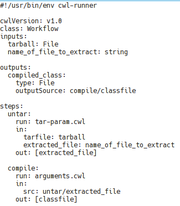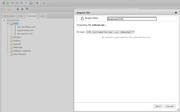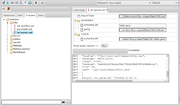Difference between revisions of "CWL"
Ilya Kiselev (Talk | contribs) |
Ilya Kiselev (Talk | contribs) |
||
| (6 intermediate revisions by one user not shown) | |||
| Line 1: | Line 1: | ||
| − | [[File:cwl_import.png|thumb|CWL import]] | + | [[File:cwl_document.png|thumb|Fig. 1. CWL document]] |
| − | [[File:cwl_analysis.png|thumb|CWL analysis]] | + | [[File:cwl_import.png|thumb|Fig. 2. CWL import]] |
| − | [[File:cwl_workflow.png|thumb|CWL workflow]] | + | [[File:cwl_analysis.png|thumb|Fig. 3. CWL analysis]] |
| − | [[File:cwl_execution.png|thumb|CWL execution]] | + | [[File:cwl_workflow.png|thumb|Fig. 4. CWL workflow]] |
| + | [[File:cwl_execution.png|thumb|Fig. 5. CWL execution]] | ||
The Common Workflow Language (CWL)<ref>Michael R. Crusoe, Sanne Abeln, Alexandru Iosup, Peter Amstutz, John Chilton, Nebojša Tijanić, Hervé Ménager, Stian Soiland-Reyes, Bogdan Gavrilović, Carole Goble, The CWL Community (2021):Methods Included: Standardizing Computational Reuse and Portability with the Common Workflow Language.Communication of the ACM. https://doi.org/10.1145/3486897 Retrieved from arXiv 2105.07028 {{doi|https://arxiv.org/abs/2105.07028}}</ref> is an open standard for describing analysis workflows and tools in a way that makes them portable and scalable across a variety of software and hardware environments, from workstations to cluster, cloud, and high performance computing (HPC) environments [https://www.commonwl.org/ (CWL website)]. | The Common Workflow Language (CWL)<ref>Michael R. Crusoe, Sanne Abeln, Alexandru Iosup, Peter Amstutz, John Chilton, Nebojša Tijanić, Hervé Ménager, Stian Soiland-Reyes, Bogdan Gavrilović, Carole Goble, The CWL Community (2021):Methods Included: Standardizing Computational Reuse and Portability with the Common Workflow Language.Communication of the ACM. https://doi.org/10.1145/3486897 Retrieved from arXiv 2105.07028 {{doi|https://arxiv.org/abs/2105.07028}}</ref> is an open standard for describing analysis workflows and tools in a way that makes them portable and scalable across a variety of software and hardware environments, from workstations to cluster, cloud, and high performance computing (HPC) environments [https://www.commonwl.org/ (CWL website)]. | ||
| Line 8: | Line 9: | ||
Standard describes execution of Command Line Tools including setting of arguments, environment requirements and conditions (e.g. execution in docker or remote server). | Standard describes execution of Command Line Tools including setting of arguments, environment requirements and conditions (e.g. execution in docker or remote server). | ||
It also describes workflow scenarios combining several tools through their inputs and outputs. | It also describes workflow scenarios combining several tools through their inputs and outputs. | ||
| + | Example workflow scenario with two steps (extracting from archive and compiling) is presented on fig. 1. | ||
Currently BioUML supports next features: | Currently BioUML supports next features: | ||
<ul> | <ul> | ||
| − | <li>Import | + | <li>Import of CWL command line tools and workflows. Representing them as data elements in BioUML repository (fig. 2).</li> |
| − | <li>Representing of CWL files as analysis methods within BioUML interface (fig. | + | <li>Representing of CWL files as analysis methods within BioUML interface (fig. 3).</li> |
| − | <li>Visual representation of CWL workflows as visual diagrams (fig. | + | <li>Visual representation of CWL workflows as visual diagrams (fig. 4). |
| − | <li>Setting of parameters and execution of CWL worklfows and tools | + | <li>Setting of parameters and execution of CWL worklfows and tools. Produced result is stored in BioUML repository (fig.5).</li> |
| + | <li>Execution is performed with reference implementation of CWL - cwltool, thus we support all features supported by it.</li> | ||
</ul> | </ul> | ||
| Line 24: | Line 27: | ||
<li>Referenced cwl files should be preliminary imported before the workflow</li> | <li>Referenced cwl files should be preliminary imported before the workflow</li> | ||
<li>Visual diagram is used only for representation of CWL scenario and can not be edited</li> | <li>Visual diagram is used only for representation of CWL scenario and can not be edited</li> | ||
| + | <li>BioUML workflows supports only files outputs and inputs. Strings, numerical and boolean values are not represented in visualisation</li> | ||
<li>Started execution of CWL scenario or tool can not be stopped manually until it is finished</li> | <li>Started execution of CWL scenario or tool can not be stopped manually until it is finished</li> | ||
</ul> | </ul> | ||
Latest revision as of 18:22, 4 February 2022
The Common Workflow Language (CWL)[1] is an open standard for describing analysis workflows and tools in a way that makes them portable and scalable across a variety of software and hardware environments, from workstations to cluster, cloud, and high performance computing (HPC) environments (CWL website).
Standard describes execution of Command Line Tools including setting of arguments, environment requirements and conditions (e.g. execution in docker or remote server). It also describes workflow scenarios combining several tools through their inputs and outputs. Example workflow scenario with two steps (extracting from archive and compiling) is presented on fig. 1.
Currently BioUML supports next features:
- Import of CWL command line tools and workflows. Representing them as data elements in BioUML repository (fig. 2).
- Representing of CWL files as analysis methods within BioUML interface (fig. 3).
- Visual representation of CWL workflows as visual diagrams (fig. 4).
- Setting of parameters and execution of CWL worklfows and tools. Produced result is stored in BioUML repository (fig.5).
- Execution is performed with reference implementation of CWL - cwltool, thus we support all features supported by it.
Currently there are several limitations in CWL support which we plan to overcome in future:
- CWL tools may be imported only in designated folder within BioUMl interface. (Workflows can be imported anywhere)
- Only workflows referencing separate cwl files as their steps can be imported
- Referenced cwl files should be preliminary imported before the workflow
- Visual diagram is used only for representation of CWL scenario and can not be edited
- BioUML workflows supports only files outputs and inputs. Strings, numerical and boolean values are not represented in visualisation
- Started execution of CWL scenario or tool can not be stopped manually until it is finished
[edit] References
- ↑ Michael R. Crusoe, Sanne Abeln, Alexandru Iosup, Peter Amstutz, John Chilton, Nebojša Tijanić, Hervé Ménager, Stian Soiland-Reyes, Bogdan Gavrilović, Carole Goble, The CWL Community (2021):Methods Included: Standardizing Computational Reuse and Portability with the Common Workflow Language.Communication of the ACM. https://doi.org/10.1145/3486897 Retrieved from arXiv 2105.07028 doi:https://arxiv.org/abs/2105.07028



